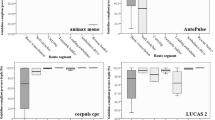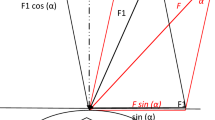Abstract
The aim of this study is to determine the conditions necessary to achieve optimum chest compression (CC) performance during constant peak displacement cardiopulmonary resuscitation (CPR). This was accomplished by first performing a sensitivity analysis on a theoretical constant peak displacement CPR CC model to identify the parameters with the highest sensitivity. Next, the most sensitive parameters were then optimized for net sternum-to-spine compression depth, using a two-variable non-linear least squares method. The theoretical CC model was found to be most sensitive to: thoracic stiffness, maximum sternal displacement, CC rate, and back support stiffness. Based on a two-variable, non-linear least squares analysis to optimize the model for the net sternum-to-spine compression depth during constant peak displacement CPR, it was found that the optimum ranges for the CC rate and back support stiffness are between 40–120 cpm and 241.0–1198.5 Ncm−1, respectively. Clinically, this suggests that current ERC guidelines for the CC rate during peak displacement CPR are appropriate; however, practitioners should be aware that the stiffness of the back support surfaces found in many hospitals may be sub-optimal and should consider using a backboard or a concrete floor to enhance CPR effectiveness.





Similar content being viewed by others
Abbreviations
- m 1 :
-
Sternal mass (g)
- m 2 :
-
Thoracic mass (g)
- μ 1 :
-
Sternal damping coefficient (Ncm−1 s−1)
- μ 2 :
-
Back support damping coefficient (Ncm−1 s−1)
- k 1 :
-
Sternal spring constant (Ncm−1)
- k 2 :
-
Back support spring constant (Ncm−1)
- r :
-
Residual (cm)
- t :
-
Time (s)
- x :
-
Displacement (cm)
- x 1 :
-
Absolute sternal displacement (cm)
- x 1,max :
-
Maximum sternal displacement (cm)
- x 2 :
-
Back support displacement (cm)
- ω :
-
Angular frequency of compression (rads−1)
References
Mathworks Inc. (2010) MATLAB Function Reference—lsqcurvefit. http://www.mathworks.com/support/tech-notes/1500/1508.html#section2. Accessed 30 Sept 2010
Andersen LØ, Isbye DL, Rasmussen LS (2007) Increasing compression depth during manikin CPR using a simple backboard. Acta Anaesthesiologica Scand 51:747–750
Aufderheide TP, Lurie KG (2004) Death by hyperventilation: a common and life-threatening problem during cardiopulmonary resuscitation. Crit Care Med 32(9):S345–S351
Babbs CF, Kern KB (2002) Optimum compression to ventilation ratios in CPR under realistic, practical conditions: a physiological and mathematical analysis. Resuscitation 54:147–157
Babbs CF, Nadkarni V (2004) Optimizing chest compression to rescue ventilation ratios during one-rescuer CPR by professionals and lay persons: children are not just little adults. Resuscitation 61:173–181
Bates DM, Watts DG (1988) Nonlinear regression analysis and its applications. Wiley, New York, pp 39–66
Boe JM, Babbs CF (1999) Mechanics of cardiopulmonary resuscitation performed with the patient on a soft bed vs. a hard surface. Acad Emerg Med 6(7):754–757
Braga MS, Dominguez TE, Pollock AN, Niles D et al (2009) Estimation of optimal CPR chest compression depth in children by using computer tomography. Pediatrics 124:69–74
Cloete G, Dellimore KHJ, Scheffer C (2011) Investigation of the impact of backboard orientation and size on chest compressions during cardiopulmonary resuscitation. Accepted by Acad Emerg Med, Manuscript ID 2011AEMJ-11-105
European Resuscitation Council (2010) Guidelines for Resuscitation 2010 Section 1. Executive summary. Resuscitation 81:1219–1276
Fenele MP, Maier GW, Kern KB et al (1988) Influence of compression rate on initial success of resuscitation and 24 hour survival after prolonged manual cardiopulmonary resuscitation in dogs. Circulation 77:240–250
Fenici P, Idris AH, Lurie KG, Ursella S, Gabrielli A (2005) What is the optimal chest compression-ventilation ratio? Curr Opin Crit Care 11:204–211
Gruben KG, Guerci AD, Popel AS, Tsitlik JE (1993) Sternal force–displacement relationship during cardiopulmonary resuscitation. J Biomech Eng 115:195–201
Halperin HR, Tsitlik JE, Guerci AD et al (1986) Determinants of blood flow to vital organs during cardiopulmonary resuscitation in dogs. Circulation 73:539–550
Kern KB, Sanders AB, Raife J et al (1992) A study of chest compression rates during cardiopulmonary resuscitation in humans: the importance of rate-directed chest compressions. Arch Internal Med 152:145–149
Kouwenhoven WB, Jude JR, Knickerbocker GG (1960) Closed-chest cardiac massage. J Amer Med Assoc 173:1064–1067
Nishisaki A, Nysaether J, Sutton R et al (2009) Effect of mattress deflection on CPR quality assessment for older children and adolescents. Resuscitation 80:540–545
Nolan JP, Deakin CD, Soar J et al (2005) European Resuscitation Council Guidelines for Resuscitation. Section 4. Adult advanced life support. Resuscitation 67S1:S39–86
Noordergraaf GJ, Paulussen IWF, Venema A et al (2009) The impact of compliant surfaces on in-hospital chest compressions: effects of common mattresses and a backboard. Resuscitation 80:546–552
Perkins GD, Soar J (2005) In hospital cardiac arrest: missing links in the chain of survival. Resuscitation 66:253–255
Perkins GD, Benny R, Giles S et al (2003) Do different mattresses affect the quality of cardiopulmonary resuscitation? Intensive Care Med 29:2330–2335
Perkins GD, Smith CM, Augre C et al (2006) Effects of a backboard, bed height, and operator position on compression depth during simulated resuscitation. Intensive Care Med 32:1632–1635
Safar P, Escarraga LA, Elam JO (1958) A comparison of the mouth-to-mouth and mouth-to airway methods of artificial respiration with the chest-pressure arm-lift methods. N Eng J Med 258:671–677
Turner I, Turner S (2004) Optimum cardiopulmonary resuscitation for basic and advanced life support: a simulation study. Resuscitation 62:209–217
Tweed M, Tweed C, Perkins GD (2001) The effect of differing support surfaces on the efficacy of chest compressions using a resuscitation manikin model. Resuscitation 51:179–183
Wyckoff MH, Berg RA (2008) Optimizing chest compressions during delivery-room resuscitation. Semin Fetal Neonatal Med 13:410–1415
Author information
Authors and Affiliations
Corresponding author
Appendix
Appendix
The equations governing the chest compression (CC) depth can be expressed in terms of the two most sensitive variables, back support stiffness (k 2) and CC rate, as follows:
In Eqs. 10 and 11, a(CCrate, k 2) implies a = f(CCrate, k 2) and b(CCrate, k 2 ) implies b = f(CCrate, k 2) where f indicates ‘function of’, such that a(CCrate, k 2) and b(CCrate, k 2) are defined as follows:
Subtracting Eqs. 11 from 10 yields an expression for the net sternum-to-spine compression depth, g = x 1 − x 2:
Next, differentiating f in Eq. 14 with respect to each variable gives the Jacobian matrix:
where \(\partial g({\text{CCrate}},k_{2} )/\partial {\text{CCrate and}}\;\partial g({\text{CCrate}},k_{2} )/\partial k_{2}\) respectively, are given by:
In Eqs. 16 and 17 \( {{\partial a} \mathord{\left/ {\vphantom {{\partial a} {\partial k_{2} }}} \right. \kern-\nulldelimiterspace} {\partial k_{2} }},\,{{\partial b} \mathord{\left/ {\vphantom {{\partial b} {\partial k_{2} }}} \right. \kern-\nulldelimiterspace} {\partial k_{2} }},\,{{\partial a} \mathord{\left/ {\vphantom {{\partial a} {\partial {\text{CCrate}}}}} \right. \kern-\nulldelimiterspace} {\partial {\text{CCrate}}}}\,{\text{and}}\,{{\partial b} \mathord{\left/ {\vphantom {{\partial b} {\partial {\text{CCrate}}}}} \right. \kern-\nulldelimiterspace} {\partial {\text{CCrate}}}} \) are defined as:
Rights and permissions
About this article
Cite this article
Dellimore, K.H.J., Cloete, G. & Scheffer, C. Towards optimum chest compression performance during constant peak displacement cardiopulmonary resuscitation. Med Biol Eng Comput 49, 1057–1065 (2011). https://doi.org/10.1007/s11517-011-0812-5
Received:
Accepted:
Published:
Issue Date:
DOI: https://doi.org/10.1007/s11517-011-0812-5




